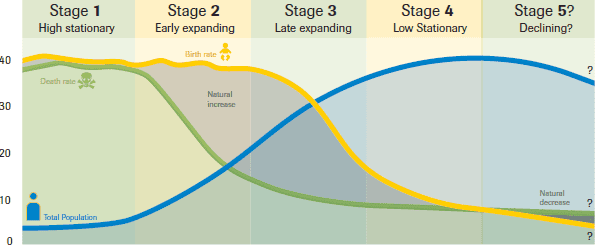This is post 5 of 6 in a series about the Demographic Transition Model – a fundamental concept in population education, which is covered in Social Studies courses, most notably AP Human Geography.

In Stage 4 of the Demographic Transition Model (DTM), birth rates and death rates are both low, stabilizing total population growth. The decline in both birth and death rates of most Stage 4 countries have been attributed to strong economies, highly educated citizens, ample healthcare systems, the migration of people from rural communities to cities, and expanded employment opportunities for women. As these factors play out the total fertility rate decreases until it reaches replacement level (2.1 births per woman), at which point the country enters Stage 5. It is understood that countries in Stage 4 of the DTM have experienced significant economic and social advances allowing for reduced family size in relation to decades prior.
Though both the birth and the death rate are ever declining, countries in Stage 4 do house large populations – a result of progressing through Stages 1-3. With a large population annual growth can still be significant even with a small rate of natural increase. Additionally, the decline in birth rate and death rate isn’t always consistent, nor are both always in decline. Both rates are susceptible to outstanding circumstances such as pandemic or environmental disasters. That being said, Stage 4 of the DTM is viewed as an ideal placement for a country because total population growth is gradual. Examples of countries in Stage 4 of the Demographic Transition are Argentina, Australia, Canada, China, Brazil, most of Europe, Singapore, South Korea, and the U.S.
Demographic Transition Stage 4 Case Study: Argentina
Since the middle of the 19th Century, Argentina has maintained a strong economy, keeping on par with Western Europe and North America. Much of the country’s development in economic and social mobility has been steady, combining with the technological and medical advances that allow for a quite rapid progression through Stages 1-3 of the DTM. Through industrialization cities became the epicenter of life, causing internal migration as people move from rural to urban areas. Due to the limited space within cities, and the changing demands of work, smaller family size becomes an indirect result of urbanization. Argentina’s transition to Stage 4 is unique when compared to the rest of South America because of how early it was accomplished – the birth rate has been in decline since the early 1900s with the only exception being the “baby boom” post World War II.
Today Argentina’s rate of natural increase is 1.1%. Though this figure is below replacement level the country still has a higher birth rate (19/1000) than death rate (7/1000), so total population will still rise. But why the early decline in birth rate? The simple answer: gender equality. Argentine women have been protected, at least in theory, by a civil code that outlaws gender discrimination since 1869. Women maintain a relatively high level of employment and educational opportunities in relation to men. Gender equality and a high status of women are large components of lowered birth rates. And while the Argentine government has historically been against contraception, today condoms and birth control are widely available without cost.
Low birth rates and low death rates characterize the countries in Stage 4 of the Demographic Transition Model. Not since Stage 1 of the DTM have birth rates and death rates been so equal in value, the main difference being that in Stage 4 total population is already high. Countries will remain categorized as Stage 4 until they reach the point where death rate exceeds birth rate, the definition of Stage 5; but there is no formula or estimate for how long that transition will take.
Demographic Transition Model blog series: Overview, Stage 1, Stage 2, Stage 3, Stage 4, Stage 5



